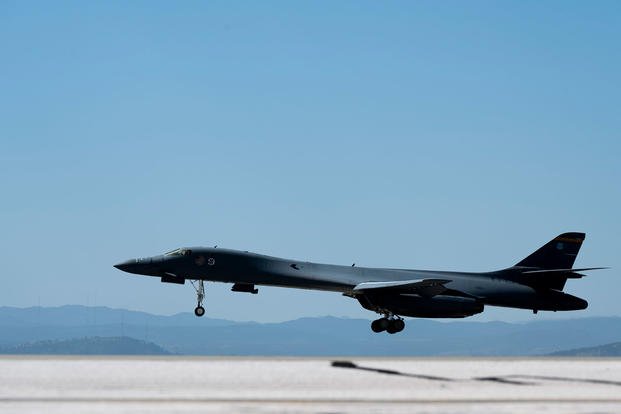B-1B Lancers at Ellsworth Air Force Base in South Dakota, as well as some of the airmen who maintain and fly them, are temporarily relocating to Texas for several weeks amid an investigation into a crash of one of the bombers earlier this month.
On Thursday, airmen at Ellsworth Air Force Base, located near Rapid City, began flying an undisclosed number of Lancers to Dyess Air Force Base near Abilene, Texas, officials from both bases told Military.com.
The move comes after a B-1B Lancer crashed earlier this month during a training mission at Ellsworth, which caused damage to the runway and paused flight operations at the base.
Read Next: After Early Troubles, New Marine Corps Amphibious Vehicle Is Headed to Okinawa
"The airfield is closed again until further notice as the Safety Investigation Board continues its work," the 28th Bomb Wing said in a statement. "Until then, we will continue operations out of Dyess AFB."
The base did not disclose the number of Lancers that were flown to Dyess. The 28th Bomb Wing also said that approximately 250 aircrew, maintainers and other support personnel are expected to work from Texas for several weeks alongside the planes.
Col. Derek Oakley, the 28th Bomb Wing commander, said the mission serves as a reminder that the B-1 force is still ready to deploy if need be, marking the first flights at the base since the crash.
"It also reassures our allies and partners that we are steadfast in supporting them when needed and reminds our nation's adversaries of the capabilities we are able to bring to any fight, anywhere around the globe," Oakley said in an emailed statement. "And while our airfield operations are currently on hold as part of the investigation, today we proved that this weapon system is mission capable."
The B-1B bomber crashed in South Dakota on Jan. 4 while trying to land at Ellsworth.
The incident, which occurred around 5:50 p.m. local time, happened during a training mission with a crew of four, Ellsworth said in a Facebook post at the time.
Two Lancers were involved in the training mission. The first one landed successfully, while the second crashed. All four crew members ejected and received medical care.
As of Friday, the damaged aircraft had not been moved and the investigation was still ongoing at the scene of the crash, the 28th Bomb Wing said.
The B-1B has been in service with the Air Force since the mid-1980s, and about 60 of the aircraft are left in the fleet. Typically, the planes are divided between Dyess in Texas and Ellsworth in South Dakota.
Each of the bombers costs roughly $317 million, according to a service fact sheet. The B-1B is a long-range bomber that at one point was nuclear-capable but hasn't been since 2007.
"The United States eliminated the nuclear mission for the B-1 in 1994," the fact sheet detailed. "Even though the Air Force expended no further funding to maintain nuclear capabilities, the B-1 was still considered a heavy bomber equipped for nuclear armament until 2007."
The crash earlier this month marks the latest incident involving a Lancer. In 2022, Military.com reported that a B-1B at Dyess caught fire, sending two people to the hospital.
The last crash of a B-1 was a little over a decade ago, when a Lancer out of Ellsworth crashed on Aug. 19, 2013, near Broadus, Montana. The crew safely ejected and no civilians were harmed, although there was damage to private property when pasture land caught fire. The loss of the aircraft was estimated at $317.7 million, according to a news release at the time.
The Air Force unveiled its latest bomber, the B-21 Raider, in late 2022. It's the first new bomber in the American military's fleet in more than 30 years and aims to eventually replace the B-2 Spirit bomber, as well as the B-1B Lancer, sometime in the 2030s.
Related: South Dakota Air Force Base Stops B-1B Lancer Flights Following Runway Crash













